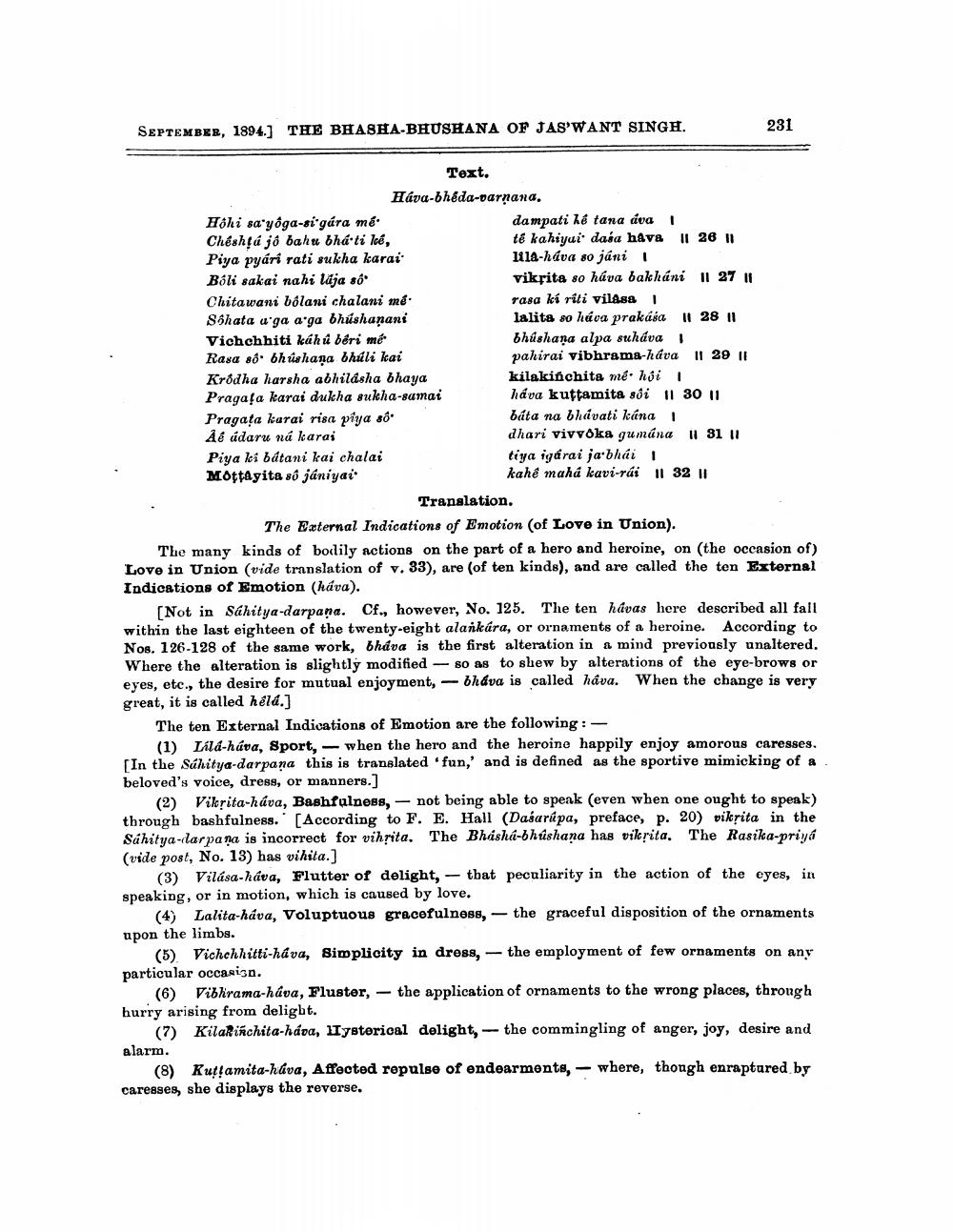________________
SEPTEMBER, 1894.] THE BHASHA-BHUSHANA OF JAS'WANT SINGH.
231
Text.
Háva-bhéda-oarnana. Höhi sa'yoga-si-gára mé.
dampati hé tana ava ! Cheshţá jó bahu bhá ti lé,
te kahiyui dasa h&va II 26 11 Piya pyári rati sukha karai
1114-háva so jáni I Bóli sakai nahi lája só
vikrita so háva bakháni il 27 11 Chitawani bölani chalani mé.
rasa ki riti vilass Sohata a'ga a'ga bhúshamani
lalita so háca prakása 11 28 11 Vichchhiti káhú béri me
bhúshaņa alpa sukával Rasa sô. bhúshana bhuli kai
pahirai vibhrama-háva 11 29 11 Krodha harsha abhilasha bhaya
kilakinchita mé. hii ! Pragaļa karai dukha sukha-samai là ca kutgamita sôi || 30 | Pragata karai risa piya sô
báta na bhavati kána 1 Åé údaru ná karas
dhari vivvoka gumána 131 11 Piya ki bátani kai chalai
tiya igárai jabhái Mottagita s8 janiyai
kahể maha kapi-rái || 12 ||
Translation. The External Indications of Emotion (of Love in Union). The many kinds of bodily actions on the part of a hero and heroine, on the occasion of) Love in Union (vide translation of v. 33), are (of ten kinds), and are called the ten External Indications of Emotion (káva).
[Not in Sahitya-darpana. Cf., however, No. 125. The ten havas here described all fall within the last eighteen of the twenty-eight alankára, or ornaments of a heroine. According to Nos. 126-128 of the same work, bháva is the first alteration in a mind previously unaltered. Where the alteration is slightly modified — so as to shew by alterations of the eye-brows or eyes, etc., the desire for mutual enjoyment, - bháva is called háva. When the change is very great, it is called héld.]
The ten External Indications of Emotion are the following: -
(1) Lila-háva, Sport, when the hero and the heroine happily enjoy amorous caresses. [In the Sáhitya-darpana this is translated 'fun,' and is defined as the sportive mimicking of a beloved's voice, dress, or manners.]
(2) Vikrita-háva, Bashfulness, - not being able to speak (even when one ought to speak) through bashfulness.' [According to F. E. Hall (Dasarkpa, preface, p. 20) viksita in the Sahitya-ılarpana is incorrect for vihrita. The Bhasha-bhushana has vikrita. The Rasika-priya (vide post, No. 13) has vihita.]
(3) Vilása-háva, Flutter of delight, - that peculiarity in the action of the eyes, in speaking, or in motion, which is caused by love.
(4) Lalita-háva, Voluptuous gracefulness, the graceful disposition of the ornaments upon the limbs.
(5) Vichchhitti-hava, Simplicity in dress, - the employment of few ornaments on any particular occasisn.
(6) Vibhrama-háva, Fluster, - the application of ornaments to the wrong places, throngh hurry arising from delight.
(7) Kilari chita-háva, Iysterical delight, - the commingling of anger, joy, desire and alarm.
(8) Kutamita-hava, Affected repulse of endearments, - where, though enraptured by caresses, she displays the reverse.




